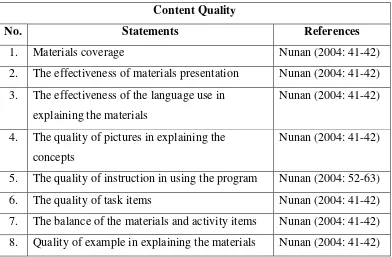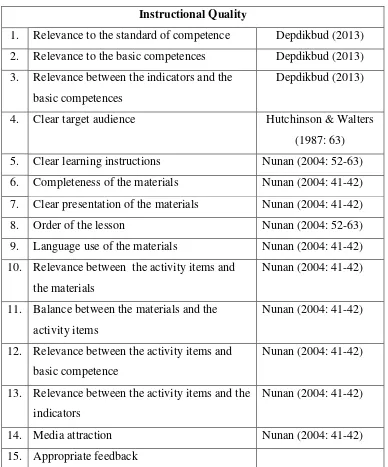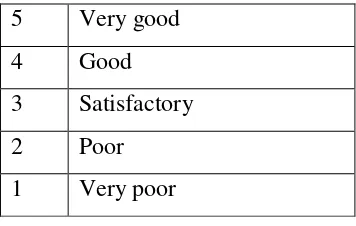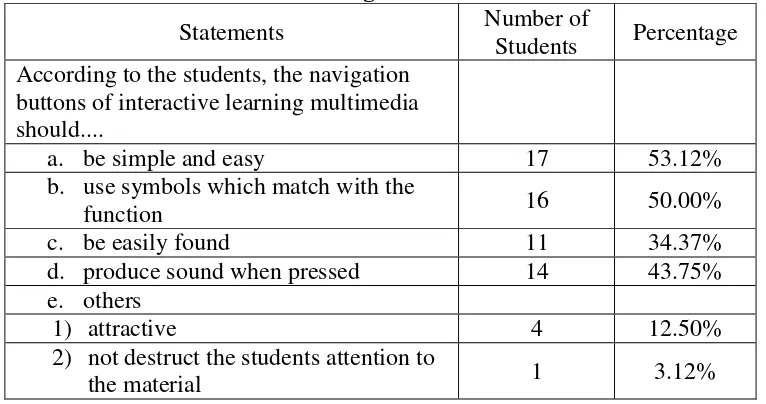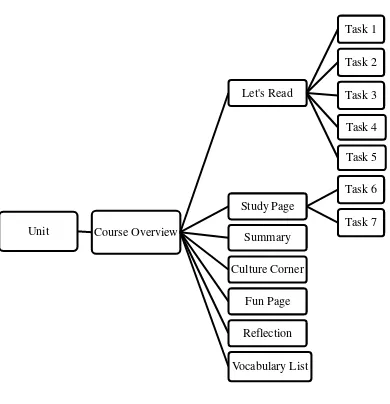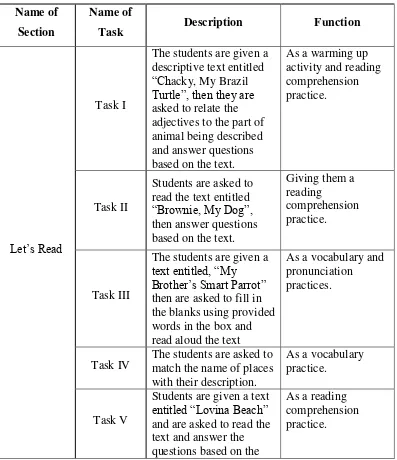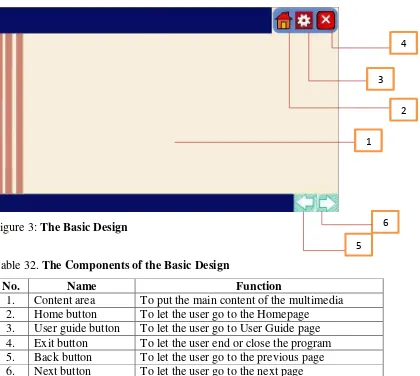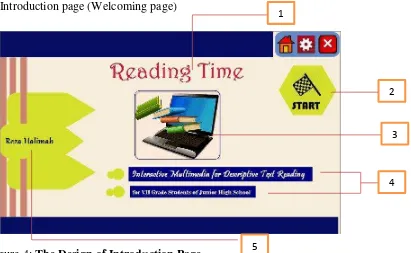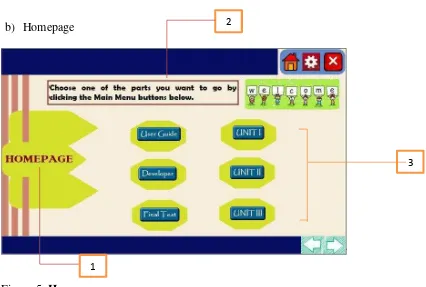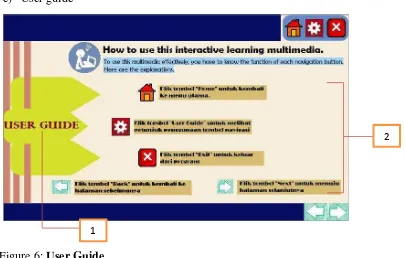A Thesis
Submitted as Partial Fulfillment of the Requirements for the Attainment of a Sarjana Pendidikan Degree in English Language Education
REZA HALIMAH 11202241007
ENGLISH EDUCATION DEPARTMENT FACULTY OF LANGUAGES AND ARTS STATE UNIVERSITY OF YOGYAKARTA
iv
Nama : Reza Halimah NIM : 11202241007
Jurusan : Pendidikan Bahasa Inggris Fakultas : Bahasa dan Seni
menyatakan bahwa karya ilmiah ini adalah hasil pekerjaan saya sendiri. Sepanjang pengetahuan saya, karya ilmiah ini tidak berisi materi yang ditulis orang lain sebagai persyaratan penyelesaian studi di perguruan tinggi ini atau perguruan tinggi lain kecuali bagian-bagian tertentu yang saya ambil sebagai acuan dengan mengikuti tata cara dan etika penulisan karya ilmiah yang lazim.
Apabila ternyata terbukti bahwa pernyataan ini tidak benar, sepenuhnya menjadi tanggung jawab saya.
Yogyakarta, Agustus 2015 Penulis
v
O believers, if you help (the cause of) Allah, He will help you and make firm your steps. (QS. Muhammad: 7)
And this worldly life is nothing but diversion and amusement. And indeed, the home of the Hereafter – that is the (eternal) life, if only they knew.
vi
Ibu, Bapak, Harun and Fahrul who indirectly show me
the path to find out the reason why I should finish this thesis
as soon as possible and what should be pursued after that.
vii
has given me courage, strength, patience, perseverance, and guidance in every second of my life. I do believe that the ease I had during the process of this thesis writing is fully under His will through all people who willingly support me in my ups and downs. It is also His blessing that I get the opportunity to meet many remarkable people who teach me priceless lesson in my life, especially during finishing my thesis and college years. Therefore, my sincere deepest gratitude is delivered to:
1. my supervisor, Drs. Suharso, M. Pd., for the guidance, knowledge, feedback and encouragement from the beginning to the end of this thesis writing.
2. my material and media expert, Joko Priyana, Ph. D., for the feedback and assessment towards my interactive learning multimedia.
3. my academic advisor, Prof. Sugirin, Ph. D., for always giving me and my classmates advice at the beginning of each semester during the college years. 4. all lecturers of English Education study program who have shared their
knowledge and experience in class.
5. my family; Ibu, Bapak, Harun, and Fahrul, for the countless prayer and support for me, for always indirectly remembering me what I should pursue in my life. 6. Putri Ayu family; Upik, Vica, Rani, Lia, Cindy, Beta, mbak Ditri, Acy, Tita,
mbak Windy, mbak Danik, mbak Vinna Vinni, mbak Fania, mbak Ita, and mbak Zizah for always educating me how to think and behave properly, for treating me very well as if I was one of their family members. I do learn so many things from those amazing people.
viii
8. all of Arroyyaan 1 family that cannot be mentioned one by one for the friendship.
9. PBI A 2011; Nabilla, Dinda, Aping, Titin, Fazri, Pus, Wilis, Eis, Eva, Bondan, Rere, Marlin, Meta, Gumy, Intan, Uwi, Anis, Sinta and Reisa for the unforgettable experience during college years.
10. the principal, English teachers, and the VII B students of SMPN 6 Yogyakarta that have given me a chance to do the research there and been very cooperative during the research.
11. all the staffs of Customs and Excise office of Yogyakarta, especially mbak Dias, mbak Shinta, mas Ghiza, mbak Indah, Farid, Danar, Aman, Tommy, Rizky, Lukman, Gasyudha, Irfan, Krisna and Iqbal who have been very great partners during my job training of English for Business. Without them, I can finish my thesis for about one month or two months earlier, but seriously, the delay was worth all periceless experience and knowledge we shared.
12. all people who have helped me along the process of my thesis writing, yet whose name I cannot mention one by one.
Finally, I do realize that my thesis is still far from perfection even though I have done my best for it. I do hope that this will be fruitful for everyone, especially those who are interested in materials development.
Yogyakarta, August 21, 2015
ix
CHAPTER I INTRODUCTION A. Background of the Study ... 1
f. Reading Comprehension Technique and Strategies ... 18
c. The Roles of Instructional Media in the Teaching and Learning Process ... 41
d. Advantages of Using Interactive Learning Multimedia ... 46
7. Multimedia for Teaching Reading ... 47
8. Developing an Interactive Multimedia Program ... 48
b. Models of Developing Interactive Multimedia Program ... 48
9. Some Software Used in Developing Interactive Multimedia .... 49
B. Relevant Research Studies ... 50
C. Conceptual Framework ... 51
CHAPTER III RESEARCH METHOD A. Type of Research ... 53
CHAPTER IV RESEARCH FINDINGS AND DISCUSSION A. Research Findings ... 63
b. Expert Judgment towards Instructional Quality ... 104
c. Expert Judgment towards Technical Quality ... 105
d. Expert Judgment towards Media Quality ... 106
a. Suggestions from Material Expert and the Revision ... 107
b. Suggestions from Media Expert and the Revision ... 108
6. The Final Draft of the Interactive Learning Multimedia ... 109
B. Discussion ... 123
1. The Content of the Interactive Learning Multimedia ... 123
2. The Media Aspects of the Interactive Learning Multimedia ... 123
CHAPTER V CONCLUSIONS AND SUGGESTIONS A. Conclusions ... 127
B. Suggestions ... 131
REFERENCES ... 133
xiii
Reading for Grade VII Students of Junior High School ... 25
Table 2: Goals, Purposes and Ways of Assessing Reading ... 27
Table 3: The Organization of the First Questionnaire (Needs Analysis) ... 57
Table 4: The Organization of the Second Questionnaire (Expert Judgment) .. 58
Table 5: The Organization of the Questionnaire for Materials Expert ... 58
Table 6: The Organization of the Questionnaire for Media Expert ... 59
Table 7: The Numerical Scale ... 61
Table 8: Quantitative Data Conversion by Sudjono (2003: 335) ... 62
Table 9: Data of Respondents in Needs Analysis Stage ... 64
Table 10: Students’ View about Goals of Learning English ... 64
Table 11: Students’ View about Goals of Reading English Texts ... 65
Table 12: Students’ View about Their Lacks in Reading English Texts ... 66
Table 13: Students’ View about Their Wants in Reading English Texts ... 66
Table 14: Students’ View about the Models of the English Text They Like .. 67
Table 15: Students’ View about Topics of Input Text ... 68
Table 16: Students’ View about Lengths of the Input Text ... 68
Table 17: Students’ View about Reading Activity which Aims to Enrich Their Vocabulary ... 69
Table 18: Students’ View about Reading Activities which Aim to Enrich Their Knowledge about English Sentence Structure ... 70
Table 19: Students’ View about the Way to Do the Task ... 70
Table 20: Students’ View about Techniquess of Teaching Reading ... 70
Table 21: Students’ View about Teacher’s Role in Teaching Reading ... 72
Table 22: Students’ View about Their Role in Learning Reading ... 72
xiv
Table 25: Students’ View about Background Colours in the Interactive
Multimedia ... 74
Table 26: Students’ View about Font of Interactive Multimedia ... 75
Table 27: Students’ View about Navigation ɒuttons of Interactive Multimedia.. 75
Table 28: Students’ View about the Availability of Answer Key in the Interactive Learning Multimedia ... 76
Table 40: The Components of Matching Quiz ... 100
Table 41: The Components of Fill in the Blank Quiz ... 101
Table 42: The Components of Multiple Choice Quiz ... 102
xv
Appendix B: Course Grid ... 143
Appendix C: The Arragement of the Materials ... 149
Appendix D: The First Draft of the Interactive Learning Multimedia ... 198
Appendix E: Expert Judgment Questionnaires and the Result ... 229
xvi
11202241007
ABSTRACT
The aims of this study are: 1) to find out the needs of Grade VII students of SMPN 6 Yogyakarta in terms of learning descriptive text reading; 2) to find out the characteristics of appropriate interactive learning multimedia that can be used to support the teaching and learning process of descriptive text reading; 3) to develop the appropriate interactive learning multimedia for teaching descriptive text reading to Grade VII students of SMPN 6 Yogyakarta.
This is an educational research and development (R & D) study. The subjects of this study were Grade VII B students of SMPN 6 Yogyakarta. The research procedure followed the model proposed by Jolly and Bolitho with a little modification. The steps were identification of the needs for material, exploration of the needs, contextual realisation of the materials, pedagogical realisation of the materials, productions of the materials, expert judgment, and revision. The data collection instruments were needs analysis questionnaire and expert judgment questionnaire. The data from needs analysis were analysed quantitatively utilizing frequencies and percentages and the result were used to develop the course grid. The quantitative data obtained from the expert judgment were converted into descriptive analysis whereas the comments and suggestions were used to revise the first draft to become the final product.
1
In this chapter, the researcher presents six sub-chapters, namely the background of the study, identification of the problem, delimitation of the problem, formulations of the problem, objectives of the study, and the significances of the study.
A. Background of the Study
Nowadays, English serves as a lingua franca in many parts of the world. It means that English is used among different groups of people for communication. The language is used as a second or foreign language for one of or both of the speakers. It shows that English has a power as a language for communication. In Indonesia, it is taught as the first foreign language in the formal schools. It is taught from the elementary level as a local content up to the secondary level as a compulsory subject.
Talking about reading, people will automatically think about some texts. Students have to deal with texts from many sources such as books, the internet, newspapers, magazines and so forth in order to gain knowledge, get some information, and reach other purposes. It is why language teachers devote considerable time and effort to promote the reading skill among their students. Besides its role as a medium for students to get knowledge and new information, reading is one of the important tools for assessing students’ language ability. This is proven by the fact that the final examination for the junior high school in Indonesia is in the form of the written texts most of which contain various text types and one of them is the descriptive text. If the students do not understand the text well, they may fail to do the test.
According to the school-based curriculum, the junior high school students in Indonesia should learn many texts including essays and short functional texts. The essays include descriptive, narrative, report, recount and procedure texts, while the short functional texts are notices, warnings, greeting cards, announcements, and invitations. Every text type has its own generic structure and linguistic elements that are different from one another. The descriptive text will be the first genre of those texts that will be taught to Grade VII students in the junior high school. However, it is not easy to encourage them to read and understand the descriptive text since the text usually consists of some paragraphs which are totally different from the previously taught texts, namely short functional texts.
teaching and learning process, including in the teaching and learning of reading. The learning materials help the teachers to deliver the instruction and information to the students and facilitate the students to understand the instruction given by the teachers. There are many kinds of learning materials that can be used to teach reading, e.g. magazines, newspapers, charts, images and some technological aids. By considering that learning materials are significant to make the process of teaching reading run well and achieve the goals, the teachers have to design the learning materials carefully.
In relation to learning materials, teachers tend to use textbooks or other printed materials to teach reading. They consider the textbooks as the main materials and other materials which are from the internet, magazines, newspapers as the additional ones. Nowadays, there are many textbooks that are well-designed and the teachers can use them to teach reading to their students, yet the teaching and learning process of reading will be just a series of monotonous activities such as reading a text and answering the questions. The consequence is that the students will get bored easily. Eventually, it can be concluded that teaching reading by using textbooks is not enough. That is why teachers need more than textbooks or printed materials to assure that the teaching and learning process of reading runs well and the students are engaged. The teachers should innovate the learning materials and media.
and tape recorder. There are also personal computers (PCs), laptops, LCD projectors and internet which can facilitate the teaching and learning process. Teachers can combine some media such as texts, pictures and videos into a package. A package of some media called multimedia is now available. The multimedia contains more interactive features than printed materials. The availability of multimedia challenges the teachers to utilize it appropriately based on the learning needs.
In the English teaching and learning process, the use of multimedia as teaching media undoubtedly helps the students to be autonomous learners and makes the teaching and learning process a learner-centered process since the interactive features in the multimedia give the students an opportunity to study independently. Furthermore, the elements of multimedia such as videos, recordings and pictures can show the students the models of target language uses. However, there is a problem in the implementation of interactive multimedia in the English teaching and learning process. As stated earlier, most of the teachers tend to use printed materials rather than interactive multimedia, especially in reading. As a consequence, the students get bored easily. In addition, teachers who use multimedia in their teaching often find some difficulties in finding the appropriate learning sources. Even though many interactive multimedia sources can be found easily, those which fulfil the requirements of national standard of competencies are still limited.
reading. The focus of this study is developing appropriate interactive multimedia for teaching descriptive text reading which can fulfil requirements of national standard of competencies.
B. The Identification of the Problems
Based on the background of the study, the researcher identified some main problems in relation to the teaching and learning process of reading, especially descriptive text reading. The problems are analysed and then elaborated in this section.
The first problem is related to the material sources used by the teachers. As stated in the previous sub-chapter, most of the English teachers’ learning material sources are just from textbooks or other printed materials. The teachers give a text to the students and ask them to read the text and then do the tasks based on the instruction. The tasks are easily predicted by them and therefore their curiosity is not well-developed. Those activities will make them easily get bored since the learning materials are monotonous.
in this case descriptive text. However, the teachers are unable to teach all of the activities because of the limitation of the time. The time allocation for English in junior high school that the researcher has observed is just forty minutes in a meeting and there will be four meetings in a week. In those meetings, the teacher should deliver the materials and give the test including the main and remedial test. Therefore, the time is very limited for the teachers to deliver all of the activities in the textbooks.
The last problem is about the availability of the interactive multimedia sources. Actually, there are many interactive multimedia sources available in the CD rentals or bookstores, but the one that fulfil the national standard requirement is rarely found. It is found that the standardized textbooks are more easily found than the standardized interactive multimedia. That is one of the reason of some teachers not to use the interactive multimedia.
C. The Delimitation of the Problems
D. Formulation of the Problems
Based on the background of the study, identification of the problem and delimitation of the problem, the research problems can be formulated as follows.
1. What are the needs of Grade VII students of SMPN 6 Yogyakarta in term of learning descriptive text reading?
2. What are the characteristic of appropriate interactive learning multimedia that can be used to support the teaching and learning process of descriptive text reading?
3. What is the appropriate interactive learning multimedia for teaching descriptive text reading to Grade VII students of SMPN 6 Yogyakarta?
E. Objectives of the Research
Based on the delimitation and formulation of problem above, the objectives of this research are:
1. to find out the needs of Grade VII students of SMPN 6 Yogyakarta in terms of learning descriptive text reading.
2. to find out the characteristic of appropriate interactive learning multimedia that can be used to support the teaching and learning process of descriptive text reading.
F. Significances of the Research
The results of this study are hoped to give some practical and theoretical significances for these following parties:
1) Practical Significances a. English Teachers
The English teachers of SMPN 6 Yogyakarta can use the findings of this study to solve the problem in the classroom. In other words, they can implement the use of this interactive multimedia to deliver descriptive text materials in a more interesting way. Furthermore, the findings of this study can also be used as a means to motivate the teachers to vary their learning materials and media so that the students will not get bored easily with the teaching and learning process.
b. Students
The researcher expects that this study will help the students comprehend English descriptive text more easily and motivate them to love reading.
c. Other Researchers
2) Theoretical Significance
10 CHAPTER II
LITERATURE REVIEW AND CONCEPTUAL FRAMEWORK
The objective of this study is to develop an interactive multimedia for teaching descriptive text reading to Grade VII students of the junior high school. In this chapter, the theories of reading including the way to teach and assess the reading skill, the material development, the interactive multimedia, the relevant studies, and the conceptual framework will be explained.
A. Literature Review 1. Reading
a. The Nature of Reading
Reading is considered as one of the English skills which has some significant roles in the teaching and learning process. According to Maxom (2009: 139), reading is one of the four skills which need to be learned besides listening, speaking, and writing. Reading also has a considerable role in the language reading). This can be done with or without an understanding of the contents.
In a more complex definition, Johnson (1983: 17) defines reading as “a
strategies, including problem-solving strategies, to build a model of the meaning which the writer is assumed to have intended.” ɒased on this definition, reading
not only deals with getting meaning of a text but also getting the message which the writer intends to convey. The term getting meaning differs from getting message since when someone gets the meaning of a text, there is no guarantee that he can understand the text in terms of the writer’s intention (Nuttal, 1996). It happens because every person has different prior knowledge and experiences, so it may cause different interpretations about the text.
Reading belongs to a receptive skill of English which means that it deals with responding rather than producing a text (Harmer, 2007). However, reading is seen as a complex process since it involves a great deal of the precise knowledge and reading strategies to be equipped (Spratt et al., 2005). In the previous definition, Johnson (1983) also states that reading is a complex behaviour which involves the use of the various strategies both consciously and unconsciously used. Moreover, Plaut (2005) adds to the complexity of reading that “reading is a complex task involving the rapid coordination of the visual, phonological, semantic and linguistic processes.” From those arguments, reading is not seen as a passive process. In other words, reading is an active process which needs a lot of practices.
knowledge that a reader employs in comprehending the text. Furthermore, Birch (2002: 4) considers reading as an interactive activity in three ways. They are: 1) The different processing strategies, both top and bottom, along with the
knowledge base, interact with each other to accomplish the reading.
2) The readers’ mind interacts with the written text so that the reader can understand the message.
3) The reader interacts indirectly with the writer of the texts if the text across time and space because it is the writer who is communicating the information to the readers, but it is the reader who must grasp the information from the writer.
The reading skill deals with the written texts. Written texts are not restricted as the texts that can be found in the books, newspapers, magazines, or websites. There are many kinds of written texts. Brown (2001) argues that the variety or genres of written texts are much larger than the spoken texts. He mentions twenty five genres of written texts. The following texts are included in genres of written texts mentioned by Brown (2001): non-fiction (e.g. reports, editorials, articles and dictionaries), fiction (e.g. novels and short stories), letters, greeting cards, diaries, journals, memos, messages, announcements, newspaper ‘kournalese’, academic writing, forms, applications, questionnaires, directions,
labels, signs, recipes, bills, maps, manuals, menus, schedules, advertisements, invitations, directories, and comic stripes or cartoons.
In conclusion, Grabe (2009) states that reading is “a combination of
processes” which includes a rapid process, an efficient process, a comprehending
process, an evaluative process, a learning process, and a linguistic process. He adds that those processes provide a good definition of reading.
b. Purposes of Reading
Smith (2004) says that the meaning of reading does not depend on what the reader is reading but his purpose of reading. One of the keys to reach comprehension is by knowing the purposes of reading. Some experts propose some motives of reading. Grabe and Stoller (2011) classify, at least, four purposes of reading in general: 1) reading to search for simple information and reading to skim, 2) reading to learn from texts, 3) reading to integrate information, write and critique texts, and 4) reading for general comprehension. Reading to search for information requires additional decision of the readers about the importance of the information from some sources, especially supporting one, and restructuring their own concept. In reading for general comprehension, the readers need to have skills in forming a general meaning representation of the main ideas.
c. Models of Reading Processes
While reading the text, there are mental processes occurring inside the readers’ thought. In general, there are three models of reading processes:
bottom-up model, top-down model, and interactive model. 1) Bottom-up model
It is called “bottom-up” because it starts with the text itself (Johnson,
2001). In bottom-up processing, readers must first recognize a multiplicity of linguistic signals (letters, morphemes, syllables, words, phrases, grammatical cues, and discourse markers) and use their linguistic data processing mechanisms to compose some sort of an order on these signals (Brown, 2001: 299). In other words, the reader should begin with decoding each individual letter, word, and sentence structure of the text and then build up the interpretation of meaning as a whole. Petterson (2001) says that these are the lower level processes that work to construct meaning from a recognition of sounds and words, which, when identified, are fit into larger phrasal units and then matched with related ideas stored in the long term memory.
2) Top-down model
It is the opposite of the bottom-up model. According to the explanation of Brown (2001: 299), it can be said that the top-down processing suggests the readers to form their perceptions starting with a larger object, concept, or idea
before working their way towards more detailed information. In other words,
top-down processing happens when the readers work from the general to the specific;
bring to the text; those are knowledge, experiences, expectations, and intuition to make interpretations of the text (Johnson, 2001; Brown, 2001). Therefore, it is also called as ‘concept-driven processing’ (Johnson, 2001).
When the readers are relating between what they get in the text and their background knowledge and experiences, they build schemata in their mind (Johnson, 2001). According to Artlett in Johnson (2001), schemata are mental frameworks that the readers hold as individuals and which they bring with them when they read. The theory underlying this process is called ‘schema theory’ which is defined by Gillet and Temple (1986: 207) as “a model of reading
comprehension that takes into account what readers may already know and how they go about developing and adding to schemata as they read.”
3) Interactive model
d. Micro- and Macro-Skills of Reading
To achieve different purposes in reading, a good reader needs to master reading skills. According to Grabe and Stroller (2011: 8-9), the term ‘skill’ represents linguistics processing abilities that are relatively automatic in their use and their combination. Moreover, Grabe and Stoller (2011) view skills as “general learning outcomes of goal-driven tasks, acquired gradually and eventually automatized.” ɒrown (2004: 187-188) divides the reading skills into two big
elements, namely micro-skills and macro-skills.
In micro-skills, readers are required to have skills to deal with graphemes and orthographic patterns and linguistic signals. Brown (2004) also provides the list of micro-skills of the reading comprehension as follows.
1. Discriminating among the distinctive graphemes and orthographic patterns of English
2. Retaining chunks of language of different lengths in short-term memory 3. Processing writing at an efficient rate of speed to suit the purpose 4. Recognizing a core of words, and interpret word order patterns and
their significance
5. Recognizing grammatical word classes (nouns, verbs, etc.) systems (e.g., tense, agreement, and pluralisation), patterns, rules and elliptical forms.
6. Recognizing that a particular meaning may be expressed in different grammatical forms
7. Recognizing cohesive devices in written discourse and their role in signalling the relationship between and among clauses.
1. Recognizing the rhetorical forms of written discourse and their significance for interpretation.
2. Recognizing the communicative functions of the written texts, according to form and purpose
3. Inferring context that is not explicit by using background knowledge 4. Inferring links and connections between events, ideas, etc., deduce
causes and effects, and detect such relations as main idea, supporting idea, new information, given information, generalization and exemplification
5. Distinguishing between literal and implied meanings
Grabe and Stoller (2011) add that those skills are acquired gradually. Thus, it is important to take into account that being a skilled reader needs big efforts.
e. Reading Comprehension
Reading cannot be separated with comprehension since comprehension is an essential goal of reading. Anderson (in Nunan, 2003) states that in an English class context, it should be explicitly taught by the teachers. They should keep in as one of the principles of teaching reading, because monitoring comprehension is essential to successful reading.
Smith (2004) describes comprehension as “relating aspects of the world
including texts to the knowledge, intentions, and expectations we already have in mind.” Added to this, Lynch (1996) states that comprehension involves the
extract information of written texts to construct the meaning of the texts. While Richards and Schmidt (2002: 443) list four kinds of reading comprehension. They are:
1) literal comprehension: reading in order to understand, remember or recall the information explicitly contained in a passage;
2) inferential comprehension: reading in order to find information which is not explicitly stated in a passage, using the reader’s experience and intuition, and by inferring;
3) critical or evaluative comprehension: reading in order to compare information in a passage with the reader’s own knowledge and values; 4) appreciative comprehension: reading in order to gain an emotional or
other kind of valued response from a passage.
Snow (2002) adds that comprehension consists of three major elements which are the readers, the texts, and the activities. The readers are the elements that do the comprehending. They use their skills, micros and macros, and their background knowledge to comprehend the text. The texts are elements that are to be comprehended. Reading activities definitely deal with all written texts. The readers make comprehension through them. The activities of reading are the elements in which the interaction between readers and texts occurs.
f. Reading Comprehension Techniques and Strategies
To do reading comprehension, the students need to apply various strategies. According to Mereillon (2007), reading comprehension strategies are “tools that proficient readers use to solve the comprehension problems they encounter in texts.” Brown (2001) proposes ten strategies that are applicable in
the classroom techniques for reading comprehension. They are listed below. 1. Identifying the purpose in reading.
3. Using different silent reading techniques for relatively rapid reading. 4. Skimming the text for main ideas.
5. Scanning the text for specific information. 6. Using semantic mapping or clustering. 7. Guessing when you aren't certain. 8. Analysing vocabulary.
9. Distinguishing between literal and implied meanings. 10.Capitalizing on discourse markers to process relationships.
Elsewhere, Moreillon (2007) proposes strategies to maximize readers’
impact on reading comprehension by activating or building background knowledge, using sensory images, questioning, making predictions and inferences, determining main ideas, and synthesizing.
Nuttall (1996) argues that it is important to know the students’ problems
in reading to decide what strategy to use. The students need to know how the strategies work through modelling and they need to practice them a lot (Lems et al., 2010).
2. Teaching Reading
This sub-chapter focuses on the theories about teaching reading, principles of teaching reading, teaching reading at the junior high school, and assessing reading.
a. Teaching Reading
There are some reasons why teachers should teach reading to their students. In the first place, many of the students want to be able to read texts in English either for their careers, study purposes, or simply for pleasure. The second reason stated by Harmer (1998: 68) is that any exposure to English is a good thing for language students. At very least, some of the language sticks in their minds as a part of the processes of language acquisition, and, if reading text is especially interesting and engaging, acquisition is likely to be even more successful. Harmer (1998: 68) also adds that reading texts provide good models for English writing. When we teach the skills of writing, we will need to show students models of what we are encouraging them to do. According to him, reading texts also provide opportunity to study language: vocabulary, grammar, punctuation, and the way sentences, paragraphs, and texts are constructed. The last reason stated by him is that good reading texts can introduce interesting topics, stimulate discussion, excite imaginative responses, and be the springboard for well-rounded, fascinating lessons.
Teachers who teach reading not only transfer the knowledge to their students but also play other important roles in order to enhance the students’
students’ characteristics, ages, needs, and interests. It is also significant for the
teacher to create engaging condition and fun class atmosphere that can raise students’ motivation to read.
b. Principles of Teaching Reading
To conduct reading activities, teachers should attend some principles of teaching reading. Harmer (1998: 70) mentions six principles of teaching reading. 1) Reading is not a passive skill.
Reading is an incredibly active occupation so the students have to understand what the words mean, see the pictures the words are painting, understand the arguments, and work out if we agree with them.
2) Students need to be engaged with what they are reading.
Students who are not engaged in the reading activities are less likely to benefit from it. When they are really fired up by the topic or the task, they get much more from what is in front of them.
3) Students should be encouraged to respond to the content of a reading text, not just to the language.
The teachers have to give students a chance to respond to the message of the text by asking their feeling about the topic.
4) Prediction is a major factor in reading.
active process of reading is ready to begin. Therefore, teachers should give students ‘hints’ so that they can predict what’s coming too. It will make them
better and be more engaged readers.
5) Teachers should match the task to the topic.
Once the teachers have taken a decision about what reading text the students are going to read, they need to choose good reading tasks. The most interesting text can be undermined by asking boring and inappropriate questions; the most commonplace passage can be made really exciting with imaginative and challenging tasks.
6) Good teachers exploit the text to the full.
Any reading text is full of sentences, words, ideas, descriptions, etc. It does not make sense just to get students to read it and the drop it to move on to something else. Good teachers integrate the reading text into interesting class sequences and use the topic for discussion and further tasks.
c. Teaching Reading at Junior High Schools
In teaching English at junior high school, the teacher should consider the characteristics, ages, needs, and interests of the students. Junior high school students, considering their ages, belong to teenager. Penny Ur in Harmer (2001: 38) suggests that teenage students are in fact overall the best language learners. Added to this, Harmer (1998: 2) says:
“They may push teachers to the limit, but they are much happier if that challenge is met, if the teacher actually manages to control them, and if this is done in a supportive and constructive way so that he or she ‘helps rather than shouts’.”
He also states that teenagers, if they are engaged, have a great capacity to learn, a great potential for creativity and a passionate commitment to things which interest them.
Herbert Puchta and Michael Scratz in Harmer (2001: 39) see the problems with teenager as resulting in part, from ‘. . .the teacher’s failure to build bridges between what they want and have to teach and their students’ worlds of
thought and experience’. Students must be encouraged to respond to texts and
situations with their own thought and experience, rather than just by answering questions and doing abstract learning activities. Teachers must give them tasks which they are able to do rather than risk humiliating them. According to the theories above, it can be concluded that teenager learners can be very potential if the teachers know how to deal with them. Therefore, the teachers’ duty is provoking students’ engagement with materials which are relevant and involving.
a curriculum includes some ways or methods as manual of learning activities in order to achieve some specific educational purposes. The school-based curriculum is now the curriculum applied in the schools by the Ministry of Education. The Ministry of Education has arranged the regulations which standardize the national
curriculum. So the teacher should use the curriculum documents as the guideline
in making decision about what to teach and how to teach. Based on the
curriculum, students of junior high school should attain some competencies
related to reading. The competencies can be attained by mastering reading
materials. The learning materials of reading stated in that curriculum are short
functional texts such as tables, lists, cautions and warnings and essays in the form of descriptive texts and procedure texts.
Based on the background of this study, identification of problem and delimitation of problem, the researcher focuses on descriptive text. According to the school-based curriculum, there are one standard of competence and two basic
competences of descriptive text reading. The following table presents the standard
of competence and basic competences (SK and KD) of descriptive text reading for
Grade VII students of the junior high school according to Badan Standar Nasional
Table 1. Standard of competence and basic competences of descriptive text reading for grade VII students of junior high school.
Standard of competence Basic competences
11. Understanding the meaning of written functional text and short and simple essays in form of descriptive and procedure related to students’ surrounding.
11.2 Responding to the meaning and rhetoric step accurately, fluently and appropriately in the very simple
essays related to students’
surrounding in form of descriptive and procedure.
11.3 Reading aloud meaningfully the short and very simple essays in form of descriptive using correct
pronunciation.
The table shows that, in the teaching and learning of descriptive text reading, Grade VII students of the junior high school are expected to achieve the competencies of understanding the written language to access knowledge about the object being described and understanding the way to read the text using correct pronunciation.
According to Brown (2001), reading can be divided into silent and oral reading. Oral reading is taught to the beginning and intermediate students of English, while silent reading is taught to the intermediate and advance level. In this case, descriptive text reading is also included in silent reading which aims to comprehend the texts well. Brown (2001) and Vaughn & Bos (2009) describe stages of the teaching reading comprehension. The stages are summarized as follows:
1) Before reading
reading such as skimming, scanning, predicting, and activating schemata that can help students understand the text should be introduced in this stage. The use of prompts such as visuals, realia, photos, and videos is recommended. The use of those items will facilitate the students to think about how the text they read may be related to other texts.
2) During reading
In this stage, the teacher monitors the students’ comprehension by
encouraging them to self-questions. 3) After reading
In this last stage, the teacher provides some follow-up activities like discussing the content of the text, retelling the idea of the text, answering comprehension questions, learning vocabulary found in the text, identifying the author’s purpose, and identifying the main idea and supporting details of the text.
b. Assessing Reading
assessments are systematic, planned sampling techniques constructed to give teacher and student an appraisal of students’ achievement. To extend the tennis
analogy, formal assessments are the tournament games that occur periodically in the course of a regimen of practice. On the other hand, informal assessment can take a number of forms, starting with incidental, unplanned comments and responses, along with coaching and other impromptu feedback to the student. Furthermore, a good deal of a teacher's informal assessment is embedded in classroom tasks designed to elicit the performance without recording results and making fixed judgments about a student's competence.
An assessment can be done by test, interview, questionnaire, observation, etc. Nation (2009) states that there are several reasons for assessing reading and the skills and knowledge that are involved in reading. They include assessing to encourage learning, assessing to monitor progress and provide feedback, assessing to diagnose problems, and assessing to measure proficiency. The same form of the assessment may be used for a variety of goals. More specifically, this is a table which consists of goals, purposes, and means of assessing reading proposed by Nation in 2009.
Table 2. Goals, purposes and ways of assessing reading.
Goals of assessment Purposes Ways of assessing
Motivate
Measure achievement
Encourage learning
- Monitor progress - Guide teaching
- Provide feedback to the
Diagnose problem carried out in a number of different ways. These are several examples of them.
1) Written response
The students should reproduce the probe of the text in a written form. If the teachers find an error or a mistake in their writing, the teacher should make sure if the error or mistake comes from students’ writing or from students’ reading.
2) Multiple-choice
Multiple choice responses are not only a matter of choosing one of four or, even, five possible answers. The teachers may try other formats of multiple-choice tests. Some of formats are especially fruitful at the low levels of reading, include same or different, circle the answer, true-false, choose the letter, and matching. However, the teachers should carefully choose the appropriate ‘distractors’.
3) Picture-cued tasks
the students are asked to read a series of sentences or definitions and each of them describes a labelled part of a picture or diagram. Their task is identifying each labelled item.
4) Gap-filling task
It is also called “filling-in-the-blank” task in which the students are asked to
complete sentences or passage with appropriate words or phrases based on their comprehension. Nuttal (1996) also points out that the teachers are recommended to delete words that lead to the main ideas or the cohesive devices in order to check students’ understanding.
5) Impromptu reading plus comprehension questions
This test contains many comprehension questions about main idea, expressions, idioms, phrases in context, inference, grammatical features, supporting details both stated, and unstated and vocabulary in context.
6) Scanning
This kind of assessment is carried out by presenting the students with a text and requiring rapid identification of relevant bits of information. There are some possible stimuli such as an essay, a technical report, a menu, an application form, a table or chart, etc.
7) Ordering task
8) Information transfer: reading charts, maps, graphs, diagrams
According to Brown (2004: 211-212), this assessment can be done by having these following tasks:
a) reading a graphic; answer simple, direct information questions; b) reading a graphic; describe or elaborate on information;
c) reading a graphic; infer/predict information;
d) reading a passage; choose the correct graphic for it;
e) reading a passage with an accompanying graphic; interpret both; f) reading a passage; create or use graphic to illustrate.
3. Materials Development
a. The Definition of Materials
In language teaching, anything which can be used by teachers or learners to facilitate the learning of a language can be named as materials. Materials may be linguistic, visual, auditory or kinaesthetic and they may be presented in a print, an audio or a video form, on CD-ROMS, on the Internet or through live performance or display (Richards and Schmidt, 2002: 322). Since a material can facilitate both teachers and students in conducting the teaching learning process, it becomes a significant aspect.
b. Learning Materials in EFL Country
developers to create and develop English materials creatively using available resources to fulfil students’ need and enable the students to learn English
successfully in a fascinating way. The teachers should be more creative and productive to create an ideal classroom environment for English learning. The materials should be delivered appropriately. One of the factors that helps a teacher in delivering the materials is instructional media.
c. Principles of Materials Development
There are some principles of materials development which are followed in this research. Tomlinson (1998: 7-21) proposes sixteen of them as follows.
1) Materials should achieve impact.
2) Materials should help learners to feel at ease.
3) Materials should help learners to develop confidence.
4) What is being taught should be perceived by learners as relevant and useful. 5) Materials should require and facilitate learner self-investment.
6) Learners must be ready to acquire the points being taught.
7) Materials should expose the learners to language in authentic use. 8) The learners’ attention should be drawn to linguistic features of the input 9) Materials should provide the learners with opportunities to use the target
language to achieve communicative purposes.
10)Materials should take into account that the positive effects of instruction are usually delayed.
12)Materials should take into account that learners differ in affective attitudes. 13)Materials should permit a silent period at the beginning of instruction.
14)Materials should maximize learning potential by encouraging intellectual, aesthetic and emotional involvement which stimulates both right and left brain activities.
15)Materials should not rely too much on controlled practice. 16)Materials should provide opportunities for outcome feedback.
4. Task-Based Language Teaching (TBLT) a. Definition of Task
When the tasks are transformed from the real world to the classroom, they become pedagogical in nature. Richards, Platt and Weber (in Nunan, 1989: 6) define a pedagogical task as”
“....an activity or action which is carried out as the result of processing or understanding language (i.e. as a response). For example, drawing a map while listening to a tape, listening to an instruction and performing a command may be referred to as tasks. Tasks may or may not involve the production of language. A task usually requires the teacher to specify what will be regarded as successful completion of the task. The use of a variety of different kinds of tasks in language teaching is said to make language teaching more communicative . . . since it provides a purpose for a classroom activity which goes beyond the practice of language for its own sake.”
From this definition, tasks are defined in terms of what the learner will do in class rather than in the world outside the classroom (Nunan, 2004:2).
Nunan (2004:4) also states that a pedagogical task is:
express meaning, and in which the intention is to convey meaning rather than to manipulate form. The task should also have a sense of completeness, being able to stand alone as a communicative act in its own right with a beginning, a middle and an end.”
Skehan (1988, in Nunan 2004: 3) puts forward five key characteristics of a task. They are :
- meaning is primary;
- learners are not given other people’s meaning to regurgigate;
- there is some sort of relationship to comparable real-world activities; - task completion has some priority;
- the assessment of the task in terms of outcome.
b. Components of Task
Nunan (2004:41) proposes a simple model of a minimum specification of task as represented in the diagram below.
Goals Teacher role
Input TASK Learner role
Procedures Settings
‘Goals’ are the vague, general intentions behind any learning task. They provide a
link between the task and the broader curriculum. ‘Input’ refers to the spoken,
are expected to play in carrying out learning tasks as well as the social and interpersonal relationships between the participants. ‘Settings’ refers to the
classroom arrangements specified or implied in the task. It also requires consideration of whether the task is to be carried out wholly or partly outside the classroom.
c. Sequencing Tasks
In developing materials, the tasks should be arranged in an appropriate order. Nunan (1985) suggests that activities can be graded according to the cognitive and performance demands made upon the learner. Nunan (1989: 118-119) also proposes the following steps of teaching sequence for written language with some modifications which can be used as a guidance to sequence the tasks developed in the Units.
1) Processing (comprehending) a) Read a text – no overt response.
b) Read a text and give a non-verbal, physical response (e.g. learner raises hand every time key words are heard).
c) Read a text and give a non-physical, non-verbal response (e.g. tick a box or grid each time key words are heard).
d) Read a text and give a verbal response (repeat or write key words when they are heard).
2) Productive
b) Read a cue and complete a substitution or transformation drill.
c) Read a cue (e.g. question) and give a meaningful response (i.e. one that is true for the learner).
d) Interactive
a) Simulation (e.g. reading a text about family, students, working from role cards, circulate and find other members of their family).
b) Discussion (e.g. students in small groups discuss texts about their families). c) Problem solving (e.g. in an information gap task, students are split into three
groups; each group read an incomplete description of a family; students recombine and have to complete a family tree, identify which picture from a number of alternatives represents the family etc.).
In this ten-step sequence, the demands on the learner gradually increase, both within each phase, and from one phase to the next. It illustrates the notion of task continuity, where skills acquired or practiced in one step are then utilized and extended in succeeding steps (Nunan, 1989: 119).
d. Principles of Task-Based Language Teaching
Nunan (2004: 35) summarizes seven underlying principles for task-based language teaching. They are explained as follows.
1) Principle 1: Scaffolding
should not be expected to produce language that has not been introduced either explicitly or implicitly.
2) Principle 2: Task dependency
Within a lesson, one task should grow out of, and build upon, the ones that have gone before.
3) Principle 3: Recycling
Recycling language maximizes opportunities for learning and activates the ‘organic’ learning principle.
4) Principle 4: Active learning
Learners learn best by actively using the language they are learning. 5) Principle 5: Integration
Learners should be taught in ways that make clear the relationships between linguistic form, communicative function and semantic meaning.
6) Principle 6: Reproduction to creation
Learners should be encouraged to move from reproductive to creative language use.
7) Principle 7: Reflection
e. Procedures in Developing Units of Materials
There are some procedures that can be applied in the material developing. Nunan (2004: 31-33) proposes a six-step procedure that enables the developer to create a linked sequence of enabling excercises and activities that will prepare the learners to carry out the tasks.
1) Schema building
Schema-building exercises will serve to introduce the topic, set the context for the task, and introduce some of the key vocabulary and expressions that the students will need in order to complete the task.
2) Controlled practice
This step is to to provide students with controlled practice in using the target language vocabulary, structures and functions.
3) Authentic listening (or reading) practice
This step involves learners in intensive listening practice. The listening texts could involve a number of native speakers in order to provide authentic materials. This step would expose them to authentic or simulated conversation, which could incorporate but extend the language from the model conversation in step 2.
4) Focus on linguistic elements
5) Provide freer practice
So far, students have been involved in what I call ‘reproductive’ language work; in other words, they have been working within the constraints of language models provided by the teacher and the materials. At this point, it is time for the students to engage in freer practice, where they move beyond simple manipulation.
6) Introduce pedagogical task
The final step in the instruction sequence is the introduction of the pedagogical task itself. Learners find it highly motivating, having worked through the sequence, to arrive at step 6 and find that they are able to complete the task more or less successfully.
f. Designing Reading Task According to TBLT
The steps to design reading tasks based on TBLT principles are divided into three stages (Zan Mao, 2012: 8). They are pre-reading, while-reading, and post-reading stage.
1) Pre-reading Stage
purposeful interaction which will fan their desire to read the text. Students may be motivated and prepare themselves better for the reading task and understand more about the passage when they get into detailed study of it.
2) While-reading Stage
At this stage, the teacher can design and assign some tasks to make students read the text efficiently and have a profound understanding. Tasks are designed to train students’ reading skills such as scanning, skimming, reading for thorough comprehension and critical reading. As for the reading activities, there are many forms that can be recommended in class: read for specific information; read for gist or general ideas of the text; deduce the meanings of certain words from a given context; infer the writer’s intended message from a given context; recognize author’s purpose and attitude.
3) Post-reading Stage
activities. They are active readers and participants in the reading tasks. The teacher is supposed to be an organizer and a guide.
5. Instructional media a. Definition
The term instruction can be defined as “the arrangement of information and environment to facilitate learning” (Smaldino, et al., 2006: 7). Based on
Gagne in Smaldino et al. (2006: 7), environment means not only where the instruction occurs but also the methods, media, and technology needed to convey information and guide the learners.
Related to the statement above, Reiser and Dempsey in 2007 asserted
b. Types of Instructional Media
(chalk, bulletin, and multipurpose), interactive whiteboards, overhead transparencies, slides, and filmstrips, audio (tape, disc and voice), video and film (tape and disc), television (live), computer software, and a website. While Smaldino et al. (2006: 57) classify media based on its format. According to them, the types of media are flip charts (still images and text), slides (projected still image), audio (moving images on TV screen), and computer multimedia (graphic, text and moving image on the monitor). Each format has different strengths and weaknesses based on types of messages which are able to be recorded and displayed.
c. The Roles of Instructional Media in the Teaching Learning Process
Instructional media serve many roles in an English teaching and learning activity as stated by Smaldino et al. in 2017 and have been summarized below.
1) Media as an instructional situation which is used for supplemental support of the teacher in the classroom. It can enhance and promote learning.
2) Instructional media can help the students to learn by themselves without the teacher’s instruction or explanation because the objective, guidance,
materials, and self-evaluation guidelines have been packaged for the students. 3) The use of technology as instructional media, such as computer and internet,
d. Instructional Media Selection
Among many types of media which are available, teachers should carefully choose the most appropriate one based on some considerations. Strauss and Frost (1999) in Seth (2009: 26) propose nine key factors which should be considered in selecting media. They are:
a) institutional resource constraints b) course content appropriateness c) learner characteristics
d) professional attitudes and skill levels e) course learning objectives
f) learning relationship g) learning location
h) time (synchronous vs. asynchronous) i) media richness level
Furthermore, Reiser and Dick (1996) in Seth (2009) state three criteria in selecting the good instructional media. They are:
1) Practicality
The practicality includes the availability of the media, cost efficiency, and time efficiency.
2) Students appropriateness
3) Instructional appropriateness
It includes three main points, which are:
a) the appropriateness of media for the planned instructional strategy; b) the efficiency and effectiveness manner offered by the media;
c) whether the media will facilitate the students acquisition of specific learning objective or not.
6. Interactive Multimedia a. The Definition
Richards and Schmidt (2002: 345) explain multimedia as the use of several different types of media for a single purpose, e.g. as in a video that uses film, audio, sound effects, and graphic images. They also add that multimedia is a collection of computer controlled or computer mediated technologies that enables people to access and use data in a variety of forms: text, sound, and still and moving images. Vaughan (2008: 1) says that multimedia becomes interactive when the users of multimedia application can control what and when some parts of the application contents will be delivered. Added to this, lesson on CAI (Computer-Assisted Instruction) materials may involve a question on the computer, a response from students, the feedback from computer telling the students if the answer is “correct”. In CAI, such activities are said to be
b. Principles of Interactive Learning Multimedia
To design interactive learning multimedia, we have to take into account seven basic principles of interactive multimedia as recommended by Mayer (2005: 6-7). The following is the list of the principles.
a) Multimedia principle: Students learn better from combination of words and graphics than from word alone.
b) Split-attention principle: Students learn better when the corresponding words and graphics are placed closely to one another than separately.
c) Modality principle: Students learn better from graphics and narrations than graphics and printed texts.
d) Redundancy principle: Students learn better when the same information is not presented in more than one format.
e) Segmenting, pre-training and modality principles: Students learn better when a multimedia message is presented in learned-paced segments rather than as a continuous unit, students know the name and characteristics of the main concepts and the words are spoken rather than written.
f) Coherence, signalling, spatial contiguity, temporal contiguity and redundancy principle: Students learn better when an extraneous material is excluded rather than included, when cues are added that highlight the organization of essential material, when corresponding words and pictures are presented near rather than far from each other on the screen or page or time and students learn better from graphics and narrations than from graphics, narration and on-screen text.
g) Personalization, voice and image principles: Students learn better when the words of a multimedia presentation are in conventional style rather than formal style and when words are spoken in a standard-accented human voice rather than a machine voice or foreign-accented human voice; but students do not necessarily learn better when the speaker’s image is on the screen.
c. Elements of Interactive Learning Multimedia
1) Text
This is the base to most applications the on-screen display of words. The use of different styles, fonts, and colours can be used to emphasize specific points. They should be easy to read. Besides, the text should be written grammatically.
2) Image
Seeing a picture of an object has more impact than merely reading about it. Examples include conventional artwork, computer-generated artwork, photographs, or captured video frames.
3) Video
It can help make learning more meaningful to students. Integrating video production into classroom activities has many benefits for students. It may encourage collaboration and requires students to be active and constructive. 4) Animation
Animations are graphic that imitate movement. All animations consist of a series of images that are shown in rapid succession and fool the eye into seeing motion.
5) Sound
Sounds can be used in strategic parts of the program or during a movie to emphasize certain points. This may include speech, audio effects and music. 6) Interactivity
7) User control
There has to be some degrees of user controls which are to provide students with the option to leave or choose certain parts of the program. On-screen options should exist for them to visit other areas of the program.
d. Advantages of Using Interactive Learning Multimedia
The researcher planned to develop interactive media by considering that interactive multimedia has many advantages in the English teaching and learning. The advantages, according to the Guide to Teaching and Learning Practices arranged by Florida State University, are that the interactive media able to:
- Gain attention. A picture on the screen, a question on the board, or music playing as students enter the room all serve to get the student’s attention. - Recall prerequisites. Teachers may use the media to help students recall what
they learned in the last class, so that new material can be attached to and built upon it.
- Present objectives to the learners. Handing out the day’s learning objectives to the students will be fruitful to both teachers and students since they will understand what they should do to attain the objectives.
7. Multimedia for Teaching Reading
In these recent years, the development of information technology leads to the integration of multimedia into teaching of English in order to create an interesting learning atmosphere. The use of multimedia in teaching of reading is expected to help the students attaining the competence. Besides, it is also expected that the use of multimedia in the teaching of reading can change students’ attitude
toward the English learning and teaching process and improve their reading skill and interest in reading.
Multimedia in teaching and learning process is commonly associated with Computer-Assisted Language Learning (CALL). CALL has come to encompass issues of materials design, technologies, pedagogical theories, and modes of the instruction. Materials for CALL can include those which are purpose-made for language learning and those which adapt existing computer-based materials, video and other materials (Beatty, 2003: 7-8). Warshchauver (1996: 3-20) says
“What makes multimedia even more powerful is that it also entails hypermedia. It means that the multimedia resources are all liked together and that learners can navigate their own path simply by pointing and clicking a mouse.”
